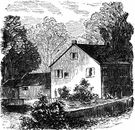The Making of the 50 States: New Hampshire
Part 1: In the Beginning The place that we now call New Hampshire was originally populated by Native Americans, among them the Amoskeag, Abenaki, Pennacook and the Sokoki. They lived in sprawling villages and grew corn, in addition to trading furs and fish. The first "official" European visitors to what we now call New Hampshire were an English explorer named Martin Pring and the French explorer Samuel De Champlain. Even John Smith got in on the action, exploring offshore islands.
The idea of New Hampshire was not, as with other American colonies, to provide a safe haven for people to practice their religion; rather, New Hampshire was envisioned as a new English colony for business and expansion. Even so, Hampton and Exeter were founded by people who disagreed with the Puritans of Massachusetts. The collection of settlements became a royal province in 1679 and stayed that way until 1698, when it was claimed by Massachusetts.
Once the English victory was secured, settlement continued in earnest, with Gov. Wentworth handing out deeds to towns to victorious soldiers and others who found favor in his eyes. The deeds had some rather unique characteristics, including that land couldn't be taxed until it was improved, tall pine trees were to be saved for the royal navy, and overall annual fees were very small, often just a shilling or even an ear of corn. Cultural improvements included the beginning of the New Hampshire Gazette, in 1756, and the opening of Dartmouth College, in Hanover in 1770. Next page > The Rest of the Story > Page 1, 2
|
|
Social Studies for Kids
copyright 2002–2024
David White



 The first settlers were Englishmen in search of a good spot to begin their fishing colony. David Thomson, the leader of the group, and others landed in 1623 at the mouth of the Piscataqua River. Part of this group set up shop at Pannaway (which is now Rye). Others went to Northam (now Dover). Other towns followed, including Portsmouth, Hampton, and Exeter. People living in these towns made their living by fishing and by trading furs and timber. Since the towns were near rivers that led to the Atlantic Ocean, settlers could get their goods to port and across the ocean to Great Britain more easily than they could if they had been nowhere near waterways.
The first settlers were Englishmen in search of a good spot to begin their fishing colony. David Thomson, the leader of the group, and others landed in 1623 at the mouth of the Piscataqua River. Part of this group set up shop at Pannaway (which is now Rye). Others went to Northam (now Dover). Other towns followed, including Portsmouth, Hampton, and Exeter. People living in these towns made their living by fishing and by trading furs and timber. Since the towns were near rivers that led to the Atlantic Ocean, settlers could get their goods to port and across the ocean to Great Britain more easily than they could if they had been nowhere near waterways. That arrangement continued until 1741, when New Hampshire successfully broke away and went back to being a royal province. This time, the province had a royal governor, Benning Wentworth. During this long period of settlement, New Hampshirites had encountered several Native American tribes. Some of those were hostile, and some were friendly. Most didn't like the idea of English settlers moving ever inward from the coast in search of new homes. During the
That arrangement continued until 1741, when New Hampshire successfully broke away and went back to being a royal province. This time, the province had a royal governor, Benning Wentworth. During this long period of settlement, New Hampshirites had encountered several Native American tribes. Some of those were hostile, and some were friendly. Most didn't like the idea of English settlers moving ever inward from the coast in search of new homes. During the 
